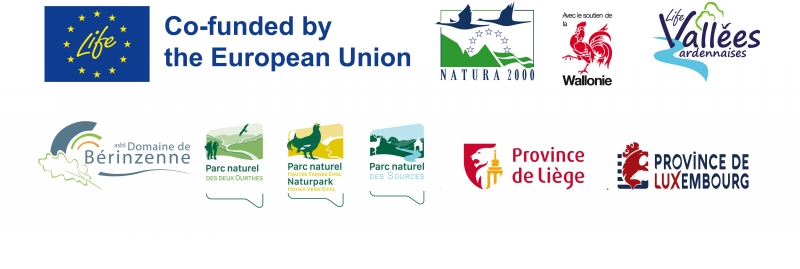
LIFE Nature and Biodiversity project “Ecological restoration of rivers and forests in the deep valleys of Ourthe, Amblève, Vesdre and Our basins” (2020-2028) will target the restoration of minor river bed and major river bed with wooded slopes of the Ardenne in deep forest valleys. Working on headwaters of the river basins will improve the quality of water and restore an ecological continuum of habitats and species of community interest. This is also the first Walloon LIFE project which addresses the overall ecological restoration of valleys.
A budget of 8,975,945 euros is released jointly by the European Commission (60%) and the Walloon Region (40%) to implement the actions of the project.
Domaine de Bérinzenne ASBL (DBZ) will be responsible for the concrete implementation of most the actions, under the control of Service Public de Wallonie – Agriculture Ressources Naturelles Environnement (SPW ARNE). Three Natural Parks involved (Parc naturel des deux Ourthes, Parc naturel Hautes Fagnes-Eifel and Parc naturel des Sources) are complementary active on most of the project sites. Liège and Luxembourg provinces are official managers of second category watercourses inside the project perimeter. Many external actors will also be involved.
The area of the project includes 36 Natura 2000 sites for a total area of 25 966 ha.
The project will include synergies with the Belgian Integrated LIFE Nature 2015-2023 (BNIP) project. It also completes the Walloon LIFE meta-project of bog restoration carried out from 2002 to 2020 through 6 LIFE projects (Croix-Scaille, Tourbières Hautes Fagnes, Tourbière Lomme, Saint-Hubert, Plateau des Tailles and Ardenne liégeoise). LIFE project Vallées ardennaises intends to follow up on the regional work of ecological restoration downstream these river basins, in deep forest valleys which follow high altitude plateaux.
ID PROJECT LIFE19 NAT/BE/000054
Project title
Ecological restoration of rivers and forests in the deep valleys of Ourthe, Amblève, Vesdre and Our basins
Financial contribution
Total 8.975.945 € with EU contribution (60%), Coordinating Beneficiary's contribution (35%), Associated Beneficiaries contribution (5%).
Duration
8 years, from 2020/09/01 to 2028/09/01.
Coordinating Beneficiary
SPWARNE (Service Public de Wallonie – Agriculture, Ressources Naturelles et Environnement).
Involved departments: DNF (Département de la Nature et des Forêts), DEMNA (Département de l'Etude du Milieu Naturel et Agricole), DDRCB (Département du Développement, de la Ruralité et des Cours d'eau et du Bien-être animal).
Associated Beneficiaries
Parc naturel des deux-Ourthes, Parc naturel des Sources, Parc naturel Hautes Fagnes-Eifel
Technical services of Liège and Luxembourg Provinces.
Area
25 966 ha, 36 Natura 2000 sites, 33 municipalities, 3 DNF “directions” (Malmedy, Marche, Liège), 11 DNF « forestry cantonments» (Bullange, Saint-Vith, Eupen, Verviers, Malmedy, Spa, Aywaille, La Roche, Marche, Nassogne) and 3 Natural Parks (PN des deux Ourthes, PN des Sources, PN Hautes-Fagnes Eifel).
For any information: Dylan Delvaux – 087/22.22.79 – life berinzenne.be
berinzenne.be
Main objective
The project intends to follow up the ecological restoration of habitats and species of Community Interest in the deep valleys of the northern and eastern Ardenne. It aims to improve the restoration of the ecological continuum of various valleys, including minor and major river beds (habitats and aquatic species, alluvial forests) and the steep slopes (slope forests and open areas).
Main actions
Restoring forested habitats of Community Interest through definitive clear-cutting of 150 ha of spruce tree (Picea abies) plantations on alluvial soils and steep slopes in the targeted valleys;
Improving watercourse ecological connectivity through suppression or technical adaptation of 37 physical obstacles to fish migration (evaluated as important, major or unpassable following the Walloon official typology and survey);
Improving the state of conservation of forested habitat remnants on a total area of 300 ha and of aquatic river habitats on a total length of 2600 m;
Consolidating existing populations and/or extending the range of three aquatic invertebrates species severely threatened at the local and regional levels : reintroduction of Astacus astacus in four headwater streams, strengthening of two remnant populations of Unio crassus (Our and Ourthe occidentale rivers), reintroduction of Margaretifera margaretifera in the upper Our basin;
Localized elimination of invasive alien plant species.
Raising land owner, stakeholder and citizen awareness of the patrimonial value and utility (through an ecosystem services approach) of the habitats and species as well as the importance of protecting and restoring them
6 habitats of Community Interest
watercourses of plain to montane level (3260)
alluvial forests (91E0*)
forests of slopes and ravines (9180*)
acidophilous beech forests (9110)
siliceous rocky slopes with chasmophytic vegetation (8220)
Medio-european upland siliceous screes (8150)
All these habitats, two of which are considered as priorities, are presently in an unfavourable bad conservation status (continental region) in Wallonia (U2 – Art. 17 reporting / 2019).
5 species of Community Interest
Margaretifera margaretifera (1029 - annex II-V)
Unio crassus (1032 – annex II et IV)
Myotis myotis (1324 - annex II et IV)
Myotis dasycneme (1318 - annex II et IV)
Myotis bechsteinii (1323 - annex II et IV)
Operational objectives
Improvement of the conservation status of habitats and species of Community interest by:
- land purchase of 100 ha forest with private owners
- long-term contract with private or public land owners for 200 ha of forest
- final abandonment, with money compensation, and cutting of 150 ha of coniferous forestry
- elimination of isolated spruce conifer seedlings in natural forests on a minimum surface of 300 ha
- cleaning of 50 ha forest cuts
- planting of 75 ha native hardwoods, with or without protection
- restoration of hydrological regime of 30 ha alluvial plots of major bed
- targeted fight against invasive alien plants in restored alluvial plots over a minimum total area of 10 ha
suppression or technical adaptation of 38 physical obstacles to fish migration
2600 m of stream length ecologically improved
- development of 7 forest fords
population consolidation and range extension of Unio crassus (controlled release of 4000 individuals) and Margaretifera margaretifera (controlled release of 2000 individuals)
installation of 150 artificial nest boxes for bats in forests and 10 on river bridges
Human ressources
Bérinzenne : Dylan Delvaux (scientific and technical coodination), Manhattan Solheid (project technician), Clémence Teugels (project technician), Lucas Lambert (administrative and financial coordination), Annick Pironet (Berinzenne supervision) ; PNDO : Nathalie Claux (project technician), Danny Klaessens (project technician) ; PNHFE : Charlotte Bontinck (project technician) ; PNS : Pierre Collard (project technician).
SPW Departments involved
DNF (Département de la Nature et des Forêts) : Direction de la Nature et des Espaces verts, Directions extérieures de Liège, Malmedy et Marche-en-Famenne, Cantonnements de Spa, Verviers, Eupen, Elsenborn, Malmedy, Bullange, Saint-Vith, Vielsalm, Aywaille, La Roche-en-Ardenne, Marche-en-Famenne, Nassogne, Neufchâteau et Saint-Hubert.
DEMNA (Département de l'Etude du Milieu Naturel et Agricole), Direction de la Nature et de l'Eau.
DDRCB (Département du Développement, de la Ruralité et des Cours d'eau et du Bien-être animal) : Direction des Cours d'eau non navigables – Districts de Liège et de Marche.
Technical services of Liège and Luxembourg Provinces
Service des Cours d'eau de la Province de Liège et Direction des Voirie et Cours d'Eau de la Province de Luxembourg.




